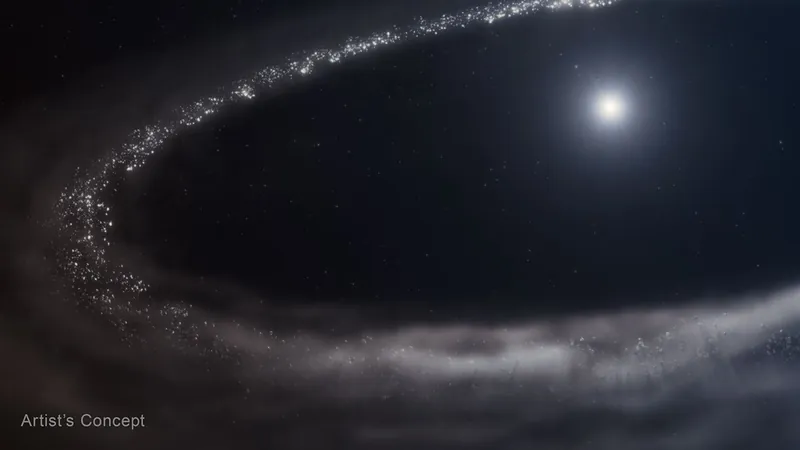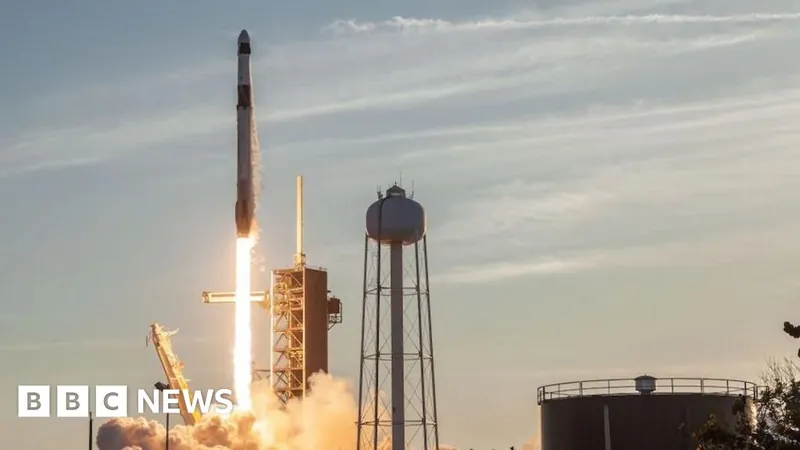
Astounding Discovery: Webb Telescope Detects Frozen Water in Distant Star System!
2025-05-14
Author: Liam
Frozen Water Found in Space: A Game-Changer!
Have you ever wondered if frozen water exists beyond our solar system? Astronomers have suspected it for years, especially after spotting water vapor in other celestial bodies. But now, thanks to the groundbreaking capabilities of the James Webb Space Telescope, scientists have confirmed the presence of crystalline water ice in a distant debris disk surrounding a sun-like star, located a staggering 155 light-years away!
Webb's Clarity: A Major Breakthrough!
This remarkable discovery was made possible through detailed spectral data captured by Webb. Lead researcher Chen Xie from Johns Hopkins University stated, "Webb not only detected water ice, but specifically crystalline water ice—similar to what we find in Saturn's rings and the icy bodies of the Kuiper Belt in our own solar system." This vital evidence supports earlier hints from the now-retired Spitzer Space Telescope, which speculated about frozen water in this star system back in 2008.
Decades of Anticipation!
Astronomers have long awaited such concrete data. Christine Chen, an associate astronomer at the Space Telescope Science Institute, recalled, "When I was a graduate student 25 years ago, my advisor insisted there must be ice in debris disks. Until Webb, we simply lacked the sensitivity to observe it!" The new findings are not only exciting but also mirror Webb’s previous observations of icy bodies in our Kuiper Belt.
Unlocking Secrets of Planet Formation!
The presence of water ice is crucial in the early stages of star systems, significantly impacting how giant planets evolve and how smaller bodies like comets deliver water to potentially habitable terrestrial planets. With Webb’s detection of water ice, researchers are now poised to delve into planetary formation processes across various star systems.
A Young Star with a Dynamic System!
The star, cataloged as HD 181327, is a mere 23 million years old—quite youthful compared to our sun, which is 4.6 billion years old. This hotter, more massive star has formed a larger surrounding system. Webb has revealed a notable gap between the star and its debris disk, offering a glimpse into a nascent system resembling our solar system’s early Kuiper Belt.
Ice: Abundant but Not Uniform!
Surprisingly, water ice is not evenly distributed within this system. Most of the ice resides in the colder, outer regions of the debris disk, where over 20% consists of water ice. As researchers moved closer to the star, they found less ice—about 8% in the middle and almost none in the innermost areas, likely vaporized by the star's intense ultraviolet light.
The Future is Bright for Astrophysical Discovery!
Excited researchers plan to continue their quest for water ice in debris disks and young planetary systems across the Milky Way. Xie emphasizes, "The presence of water ice paves the way for planet formation. Icy materials might ultimately be delivered to rocky planets formed over millions of years in these systems." With Webb’s super-sensitive tools like the NIRSpec, this incredible journey into the cosmos is just beginning!









 Brasil (PT)
Brasil (PT)
 Canada (EN)
Canada (EN)
 Chile (ES)
Chile (ES)
 Česko (CS)
Česko (CS)
 대한민국 (KO)
대한민국 (KO)
 España (ES)
España (ES)
 France (FR)
France (FR)
 Hong Kong (EN)
Hong Kong (EN)
 Italia (IT)
Italia (IT)
 日本 (JA)
日本 (JA)
 Magyarország (HU)
Magyarország (HU)
 Norge (NO)
Norge (NO)
 Polska (PL)
Polska (PL)
 Schweiz (DE)
Schweiz (DE)
 Singapore (EN)
Singapore (EN)
 Sverige (SV)
Sverige (SV)
 Suomi (FI)
Suomi (FI)
 Türkiye (TR)
Türkiye (TR)
 الإمارات العربية المتحدة (AR)
الإمارات العربية المتحدة (AR)